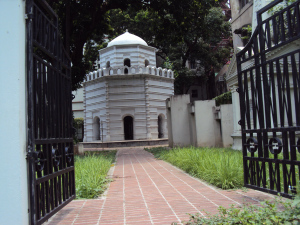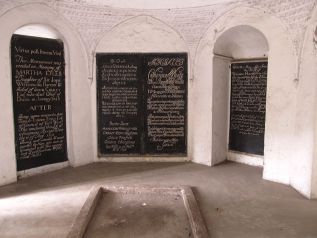Job Charnock’s Tomb
 A scorching June day in 2011, I was researching for my latest book on Job Charnock – an English merchant-adventurer, and visited his tomb in the St. John’s Church compound in Kolkata. I sat inside the mausoleum on the cold marble floor for hours and thought about the time – that is long lost. And I had a momentary vision….. a very unusual feeling…. the next moment I knew in my mind that I shall come up with a hell of a thriller.
A scorching June day in 2011, I was researching for my latest book on Job Charnock – an English merchant-adventurer, and visited his tomb in the St. John’s Church compound in Kolkata. I sat inside the mausoleum on the cold marble floor for hours and thought about the time – that is long lost. And I had a momentary vision….. a very unusual feeling…. the next moment I knew in my mind that I shall come up with a hell of a thriller.
Charnock is popularly believed to have founded the city of Kolkata. His tomb is truly a sight to behold. One of the oldest English monuments in the city. The mausoleum was built by Job Charnock’s successor and son-in-law Sir Charles Eyre, in 1695. Constructed from a unique kind of rock called ‘Charnockite’, this edifice projects the deep rooted respect that was bestowed upon this individual. The tomb itself is engraved with a short text in Latin honouring the man….
 Which says: D.O.M. Jobus Charnock, Armiger Anglus et nup. in hoc regno. Bengalensi dignissimum Anglorum Agens Mortalitatis suae exuvias sub hoc marmore deposuit, ut in spe beatae resurrectionis ad Christi judicis adventum obdormirent. Qui postquam in solo non-suo peregrinatus esset diu reversus est domum suae aeternitatis decimo die 10th Januarii 1692. Pariter Jacet Maria, Iobi Primogenita, Carole Eyre Anglorum hicci Praefecti. Conjux charissima. Quae Obiit 19 die Februarii A.D. 1696–97.
Which says: D.O.M. Jobus Charnock, Armiger Anglus et nup. in hoc regno. Bengalensi dignissimum Anglorum Agens Mortalitatis suae exuvias sub hoc marmore deposuit, ut in spe beatae resurrectionis ad Christi judicis adventum obdormirent. Qui postquam in solo non-suo peregrinatus esset diu reversus est domum suae aeternitatis decimo die 10th Januarii 1692. Pariter Jacet Maria, Iobi Primogenita, Carole Eyre Anglorum hicci Praefecti. Conjux charissima. Quae Obiit 19 die Februarii A.D. 1696–97.
The epitaph can be translated as: In the hands of God Almighty, Job Charnock, English knight and recently the most worthy agent of the English in this Kingdom of Bengal, left his mortal remains under this marble so that he might sleep in the hope of a blessed resurrection at the coming of Christ the Judge. After he had journeyed onto foreign soil he returned after a little while to his eternal home on the 10th day of January 1692. By his side lies Mary, first-born daughter of Job, and dearest wife of Charles Eyre, the English prefect in these parts. She died on 19 February AD 1696–7
The inscription omits any mention of Charnock’s Hindu wife Maria. Eyre may have hoped to make the public image of his predecessors and in-laws seem more respectable to the growing Anglican community in Calcutta. Even so, the monument was built by Bengali craftsmen, and its incorporation of Indo-Islamic design reflects the intersection of two cultures their union personified.
Victor Ghoshe





